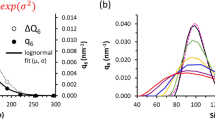Abstract
We discuss the response of aging systems with short-range interactions to a class of random perturbations. Although these systems are out of equilibrium, the limit value of the free energy at long times is equal to the equilibrium free energy. By exploiting this fact, we define a new order parameter function, and we relate it to the ratio between response and fluctuation, which is in principle measurable in an aging experiment. For a class of systems possessing stochastic stability, we show that this new order parameter function is intimately related to the static order parameter function, describing the distribution of overlaps between clustering states. The same method is applied to investigate the geometrical organization of pure states. We show that the ultrametric organization in the dynamics implies static ultrametricity, and we relate these properties to static separability, i.e., the property that the measure of the overlap between pure states is essentially unique. Our results, especially relevant for spin glasses, pave the way to an experimental determination of the order parameter function.
Similar content being viewed by others
REFERENCES
K. Binder and A. P. Young, Rev. Mod. Phys. 58:801 (1986).
M. Mézard, G. Parisi, and M. A. Virasoro, Spin Glass Theory and Beyond (World Scientific, Singapore, 1987).
K. H. Fischer and J. A. Hertz, Spin Glasses (Cambridge U. P., Cambridge, 1991).
A. P. Young (ed.), Spin Glasses and Random Fields (World Scientific, Singapore, 1997).
M. Mézard and G. Parisi, Phys. Rev. Lett. 82:747 (1999), and cond-mat/9812180.
For a recent review see E. Marinari, G. Parisi, and J. J. Ruiz-Lorenzo in ref. 4.
C. M.Z Newman and D. L. Stein, Phys. Rev. B 46:973 (1992).
G. Parisi, Phys. Rev. Lett. 50:1946 (1983).
L. C. E. Struik, Physical Aging in Amorphous Polymers and Other Materials (Elsevier, Houston, 1978).
L. Lundgren, P. Svedlindh, P. Nordblad, and O. Beckman, Phys. Rev. Lett. 51:911 (1983); P. Nordblad, P. Svedlindh, L. Lundgren, and L. Sandlund, Phys. Rev. B 33:645 (1986); M. Alba, J. Hamman, M. Ocio, and Ph. Refrigier, J. Appl. Phys. 61:3683 (1987); F. Lefloch, J. Hamman, M. Ocio, and E. Vincent, Europhys. Lett. 18:647 (1992). For a recent review see P. Norblad and P. Svendlindh in ref. 4.
L. F. Cugliandolo, J. Kurchan, P. Le Doussal, and L. Peliti, Phys. Rev. Lett. 78:3504 (1997).
L. Cugliandolo, J. Kurchan, and L. Peliti, Phys. Rev. E 55:3898 (1997).
S. Franz, M. Mézard, G. Parisi, and L. Peliti, Phys. Rev. Lett. 81:1758 (1998).
For a recent review see J.-P. Bouchaud, L. Cugliandolo, M. Mézard, and J. Kurchan in ref. 4.
J.-P. Bouchaud, J. Physique (Paris) 2:1705 (1992).
S. Franz and H. Rieger, J. Stat. Phys. 79:749 (1995); G. Parisi, Phys. Rev. Lett. 79:3660 (1997); J. Phys. A. Math. Gen. 30:8523 (1997); E. Marinari, G. Parisi, F. Ricci-Tersenghi, and J. J. Ruiz-Loretzo, J. Phys. A: Math. Gen. 31:2611 (1998); G. Parisi, F. Ricci-Tersenghi, and J. J. Ruiz-Lorenzo, Phys. Rev. B 57:13617 (1998); A. Barrat, Phys. Rev. E 57:3629 (1998); M. Campellone, B. Coluzzi, and G. Parisi, cond-mat/9804291, J. Phys. A, to appear.
D. Fisher, Physica D 107:204 (1997).
C. M. Newman and D. L. Stein, Phys. Rev. Lett. 76:515 (1996).
F. Guerra, Int. J. Mod. Phys. B 10:1675 (1997).
M. Aizenman and P. Contucci, J. Stat. Phys. 92:765 (1998).
L. F. Cugliandolo and J. Kurchan, Phys. Rev. Lett. 71:173 (1993).
S. Ghirlanda and F. Guerra, J. Phys. A: Math. Gen. 31:9149 (1998).
E. Marinari, G. Parisi, F. Ricci-Tersenghi, and J. J. Ruiz-Lorenzo, J. Phys. A: Math. Gen. 31:2611 (1998).
D. J. Gross and M. Mézard, Nucl. Phys. B 240:431 (1984).
M. Mézard, G. Parisi, and M. A. Virasoro, J. Physique Lett. 46:L21 (1985).
G. Parisi, On the probabilistic formulation of the replica approach to spin glasses, condmat/9801081.
L. F. Cugliandolo and J. Kurchan, J. Phys. A: Math. Gen. 27:5749 (1994).
S. Franz and M. Mézard, Europhys. Lett. 26:209 (1994); Physica A 210:48 (1994).
M. Mézard, G. Parisi, N. Sourlas, G. Toulouse, and M. A. Virasoro, J. Physique 45:843 (1985).
Author information
Authors and Affiliations
Rights and permissions
About this article
Cite this article
Franz, S., Mézard, M., Parisi, G. et al. The Response of Glassy Systems to Random Perturbations: A Bridge Between Equilibrium and Off-Equilibrium. Journal of Statistical Physics 97, 459–488 (1999). https://doi.org/10.1023/A:1004602906332
Issue Date:
DOI: https://doi.org/10.1023/A:1004602906332




